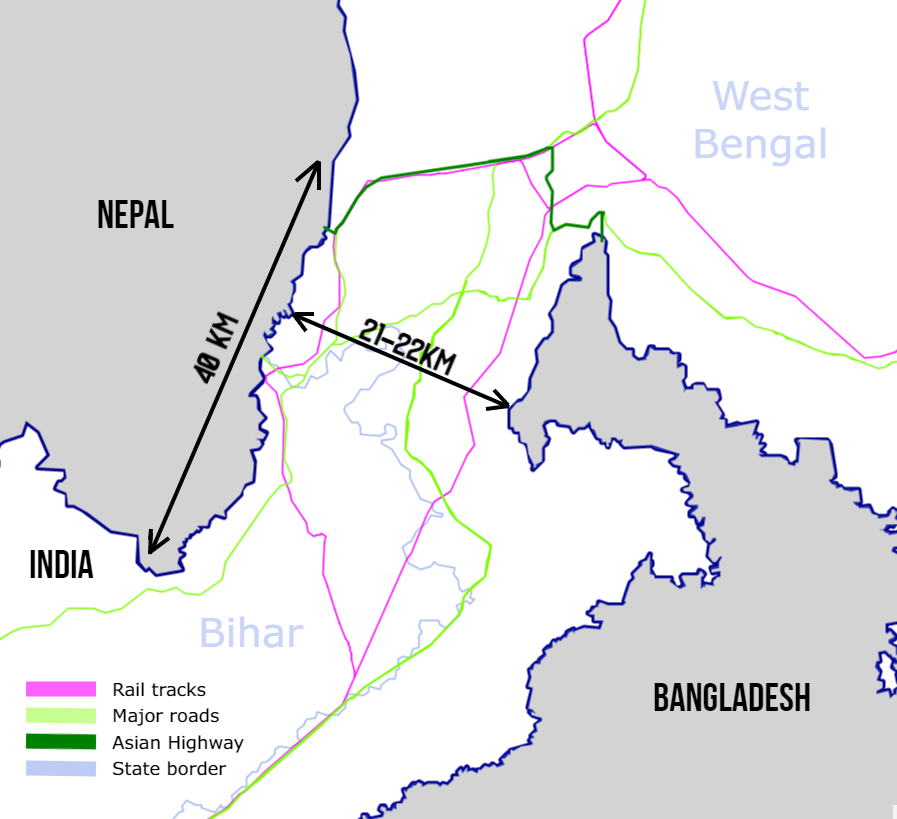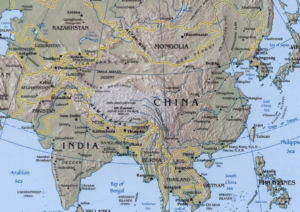- This corridor is crucial for the transport of goods and people, as well as being vital for India’s national security;
- China has increased its military presence near the Siliguri Corridor, especially in the Chumbi Valley region of Tibet and Bhutan;
- An armed conflict could not only destabilize the region, but also weaken the BRICS’ global position.
Amid tensions between India and China, a narrow strip of land, known as “Chicken’s Neck”, emerges as a point of vulnerability for India.
The dispute over this important region not only puts India’s territorial integrity at risk, but also has potential implications for regional stability and global geopolitics.

What is the Siliguri Corridor and what is its importance?
Imagine a narrow strip of land, just 17 km wide at its narrowest point, that connects a large region to the rest of the country. This is the Siliguri Corridor, often called “Chicken’s Neck”.
This strait is located in the state of West Bengal, in India, and is the only land link between the eight northeastern Indian states and the rest of the country, keeping more than 50 million people connected.

Passing through this narrow strip of land, all the essential highways and railways that transport goods and people flow ceaselessly, sustaining the region’s economy and daily life. Without this corridor, trade in products from eastern India, such as the famous Darjeeling tea and timber, would be severely hampered.
But beyond its commercial importance, the Siliguri Corridor has vital strategic importance for India’s territorial and national security. It’s as if someone trapped their head between iron bars, leaving them totally vulnerable to any external threat and losing contact with the rest of their body (the eastern part of India). This is how India sees the Siliguri Corridor.
This strip of land is surrounded by countries such as Nepal, Bangladesh and Bhutan, and just 130 km to the north lies the Chumbi Valley in Tibet, which is controlled by China. The proximity to Tibet and China’s continued construction of military infrastructure in the region raise tension in the area.
Since the clash between Indian and Chinese troops in the Galwan Valley in 2020, tensions have only increased. India, aware of the vulnerability of the Siliguri Corridor, has strengthened its military presence in the region.
The Siliguri Corridor also plays a crucial role in regional politics. It helps India closely monitor Chinese activities in Tibet and maintain a strong and prepared line of defense. The security of the corridor is also essential to ensure India’s sovereignty and territorial integrity.
What is China doing against India in the Siliguri Corridor?
China, over the years, has made strategic moves that threaten the security of the Siliguri Corridor by building military infrastructure, such as roads and airstrips, and increasing military presence in the Chumbi Valley region, China is clearly strengthening its capacity for rapid mobilization near “Chicken’s Neck”.
In June 2020, a violent clash in the Galwan Valley in the disputed territory of Ladakh (in the Himalayas region but far from the Siliguri corridor) highlighted escalating tensions between the two Asian giants. In this incident, many Indian soldiers lost their lives, and since then, both countries have intensified their military presence along the Line of Actual Control (LAC), the de facto border between India and China.
Tensions between China and India began not now, but in the mid-20th century. In 1962, both countries went to war over border issues, resulting in a brief but intense war that ended in a Chinese victory and the occupation of significant parts of the disputed territory.
Since then, borders have remained contested, especially in areas such as Aksai Chin (occupied by China but claimed by India) and Arunachal Pradesh (controlled by India but claimed by China as part of Tibet).
Because of this history, Chinese activities in the region are seen by India as movements that show China’s intentions to maintain an advantageous position, increasing pressure on India.
At any time, a Chinese military advance of just 130 km could completely cut off the corridor, isolating northeast India from the rest of the country. This would not only disrupt the flow of commerce and people, but also put the safety of millions of Indians at risk.
In response, India has strengthened its defenses in the Siliguri Corridor, building new military infrastructure and intensifying patrols and military exercises in the region. This is an effort to ensure that even in the face of possible escalation, India can effectively defend this crossing.
In addition, new bunkers – armored shelters – are being built, land is being mined to prevent attacks and soldiers carry out military exercises regularly. All this to ensure that, if necessary, India can respond quickly to any provocation.
What is Bhutan’s role in the dispute over the Siliguri Corridor?
Bhutan is a small kingdom located between China and India, which is why it plays a crucial role in the dispute over the Siliguri Corridor. Its geographical position and its alliance with India make Bhutan an important actor in this dispute.
Bhutan is situated north of the Siliguri Corridor, and any military move or infrastructure construction by China towards the Corridor must inevitably consider Bhutanese territory.
Bhutan has a friendship treaty with India that includes a defense component, whereby India undertakes to assist Bhutan in security matters.
This treaty reinforces India’s position in the Siliguri Corridor as any threat to Bhutan is seen as a direct threat to India. Thus, India maintains a large military presence in the country and collaborates closely with the Bhutanese government to monitor and counterbalance Chinese activities in the region.
So, maintaining neutrality and its sovereignty is vital. The kingdom has been careful to balance its relations with China and India, but its security is closely linked to Indian support.
Bhutan is aware that the expansion of Chinese infrastructure near its borders poses a threat not only to itself but also to regional security, including the important Siliguri Corridor.
The concern is even greater due to the recent installation of Chinese military bases in four strategic areas of Bhutanese territory, in a contested and illegal action that challenges the country’s sovereignty.
This move has significant implications for India, particularly in the Siliguri Corridor. Furthermore, China is adopting other measures, such as encouraging the migration of its citizens to these regions, in an attempt to reinforce its territorial claims and pressure Bhutan to cede these territories.
China, in turn, has tried to increase its influence in Bhutan, proposing economic deals and infrastructure improvements as part of its Belt and Road initiative.
However, these efforts are viewed with skepticism by both the Bhutanese government and India, which fears that Bhutan could fall into a Chinese “debt trap” and become more susceptible to political and military pressure from Beijing. In this way, Bhutan remains a crucial ally for India in protecting the Siliguri Corridor.
How is this dispute controversial for the BRICS?
The dispute between China and India over the Siliguri Corridor creates a dilemma for BRICS, an alliance of five large emerging economies made up of Brazil, Russia, India, China and South Africa.
Despite being members of the same economic and cooperation group, bilateral tensions between China and India challenge the unity and objectives of BRICS.
The BRICS were formed with the vision of promoting economic development, strengthening political cooperation and increasing the global influence of member countries and counterbalancing the power of the “West” which is led by the United States.
However, the territorial rivalry between two of its most influential members, China and India, introduces a component that could undermine these objectives. Both countries have actively pursued economic growth and regional leadership, but their clashes along disputed borders threaten to destabilize that cooperation.
During BRICS summits, where leaders meet to discuss and plan joint initiatives, Sino-Indian tensions often enter the debates.
Issues such as infrastructure investment, trade and sustainable development are complicated by mutual distrust and the need for each nation to defend its security interests. The presence of these tensions can make it difficult to formulate unified policies and implement collaborative projects.
Russia, another key BRICS member, often finds itself in a mediating position between China and India, given its historical relationship with both countries.
Moscow has a strategic interest in maintaining cohesion within the BRICS and preventing bilateral disputes from destabilizing the alliance. Likewise, Brazil and South Africa, although less directly involved, have an interest in preserving the integrity of the group and ensuring that regional conflicts do not harm the global economic and political objectives of the BRICS.
However, the presence of an unresolved dispute like the Siliguri Corridor and the others in the Himalayas means that the stability of the BRICS may be under threat. If a military escalation between China and India occurs, it is possible that cooperation within the group could quickly deteriorate, affecting investments, joint initiatives and the global position of the BRICS.
Furthermore, conflict puts additional pressure on other members to take sides, which can lead to internal divisions.
What are the geopolitical risks and importance of the dispute over the Siliguri Corridor?
The dispute over the Siliguri Corridor presents geopolitical risks that have implications not only for India and China but for the entire South Asian region.
Isolation of Northeast India:
- If China manages to cut off or control this corridor, India would face the possibility of isolating its seven northeastern states. This would fragment Indian territory and complicate both military and civilian logistics, making the defense of these regions extremely challenging.
Military Escalation:
- The significant military presence on both sides in the region increases the risk of direct military confrontations.
- Any incident could quickly escalate into a broader conflict, especially due to the proximity of the armed forces.
- Given the nuclear capabilities of both nations, the escalation from a conventional conflict to a nuclear confrontation is a worrying risk, with devastating consequences for the entire region.
Regional Instability:
- The dispute directly affects relations with neighboring countries such as Bhutan, which is a strategic ally of India.
- Nepal and Bangladesh, which also border the Siliguri Corridor, may be drawn into the conflict, either due to political pressures or government alliances.
Impact on Trade and Economy:
- Any disruption in this corridor due to conflicts can impact regional trade, negatively affecting local economies and reducing opportunities for economic development.
- Instability may decrease foreign investments in the region.
Challenges to Sovereignty and Territorial Integrity:
- The dispute over the Siliguri Corridor puts India’s sovereignty and territorial integrity at stake.
- India’s ability to protect and maintain its borders is crucial for its national security and its status as a regional power.
- The loss or compromise of control over the Siliguri Corridor would have profound implications for India’s perception as a nation capable of defending its territory against external aggressions.
Challenges to BRICS Cohesion:
- Polarization within BRICS could lead to a weakening of the group as a global influence bloc.
- At the same time, a conflict between China and India could indirectly benefit the United States, which sees China and its allies as geopolitical and economic rivals.
Potential for International Intervention:
- Escalation of the conflict could attract the attention and intervention of international powers such as the United States and Russia, which have interests in the region.
- India maintains a certain defense relationship with the US (via the QUAD) while also being a traditional buyer of Russian arms. China, on the other hand, has a strategic alliance of convenience with Russia to counteract the US and gain economic benefits.
- Third-party intervention could further complicate the situation, turning a regional conflict into a global crisis.





[…] concerns over China’s interest in the region, as outlined by the Atlas Report, only increase the city’s strategic […]